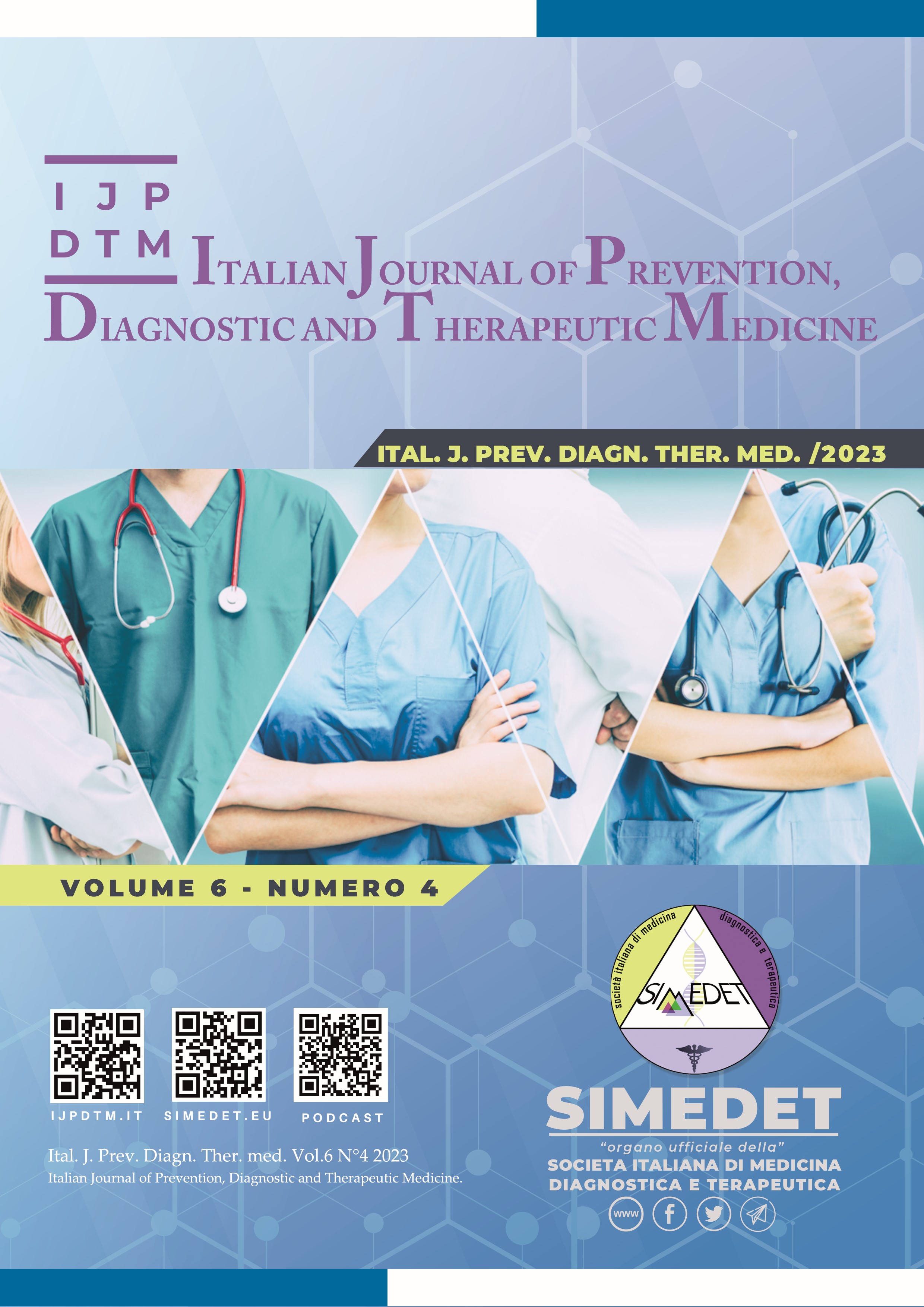The sense of responsibility and the ethic of care in the internship experience results of a qualitative investigation
Main Article Content
Abstract
One of the most important values for those who work in the clinical environment is the sense of responsibility, that has to be both legal and ethical because, in relating to a person who is suffering, to his own values and to his past, you must not only carry out the duties as clinical workers, implementing correct procedures, but also you have to defend the patient’s dignity, and infuse sense and meaning in our own profession.
The article is based on a thesis that has had as a purpose to understand if the sense of responsibility is widespread in the nursing practice, if nursing students detect that and if the nursing tutors are able to transmit that.
The aim was identified innovation elements and plan of actions to increase and modulate the nursing courses.
METHODS
The first method was essentially theoretical, which has given the foundation to examine the etymological meaning and ethical-legal of the “responsibility” term, the implications in the cure process as well as in the plan of actions turn on in the nursing internship; the second method was qualitative-experimental and it consisted in two questionnaires, one for the nursing students and the other for the nursing tutors. The questionnaires were structured through closed-ended questions and open- ended questions via drive, to allow real- time monitoring of the collected data. The underlying methodology was the phenomenological-interpretative one: the meaning perception about living life of the person in the context in which they operate.
RESULTS
Throughout the qualitative and quantitative examination of the questionnaires’ answers, it was possible to understand if the sense of responsibility is infused and how, the level of nursing students’ perception of that, the different dynamics with which they are structured and the advice to improve the education of nursing students. In the article the data graphics will be reported and their investigations.
CONCLUSIONS
The conclusions are dedicated at the investigations of some suggests by the nursing students and tutors for improving and re-modulate the tutorship in nursing practice, such as: scheduled educational meetings and constant feedback with the clinical team. Also, the necessity to start new discussion rooms about ethical and feasible strategies of therapeutic relationship. The responsibility sense should not emerge like a duty, but it should become an habitus, an essential part of our work.
Downloads
Article Details

This work is licensed under a Creative Commons Attribution-NonCommercial 4.0 International License.
References
https://books.openedition.org/aaccademia/399?lang=it
Barrow H.S. Il processo tutoriale, Fondazione SmithKline. Milano, Franco Angeli, 1990; https://www.fnopi.it/archivio_news/attualita/2688/codice%20deontologico_2019.pdf; AA.VV., La didattica laboratoriale, Università di Modena.
Tong, A.; Sainsbury, P.; Craig, J. Criteri consolidati per la segnalazione di ricerche qualitative, Int. J. Qual. Sanità 2007
Sandro Spinsanti, Etica biomedica, Edizioni Paoline,Cinisello Balsamo, 1987
Fabio Cembrani, “L’etica dei principi e l’etica della responsabilità”, in Giornale italiano di nefrologia, 2016
Idem
Riferimenti a: Comoretto N, Spagnolo A.G. (2009), Il nuovo Codice deontologico dell’infermiere: una lettura etico-deontologica, Medicina e morale; 59(4):645–672; Costanza R., La questione infermieristica: prendersi cura o curare?, Casa editrice Ambrosiana, Milano 2012; Accademia Svizzera delle Scienze Mediche (ASSM), Formazione in etica per i professionisti del settore sanitario, novembre 2018; Bentham J. , Introduzione ai principi della morale e della legislazione, 1979
Duilio Manara, Prendersi cura, Atti Convegno Scienze infermieristiche, Magenta 2011. Si veda anche Brotto Sara, Etica della cura. Una introduzione, Ethica, Napoli 2013.
A titolo di esempio, si veda M. Heidegger (Essere e tempo), U. Curi (Le parole della cura. Medicina e filosofia, 2017), Mortari Luigina (Filosofia della cura), U. Eco (Lectio magistralis sul tema del dolore).
R. Costanza, La questione infermieristica: prendersi cura o curare?, Casa editrice Ambrosiana, Milano 2012
A titolo di esempio: Student Evaluation of Clinical Education Environment (SECEE) (SandJecklin, 2009), Clinical Learning Environment and Supervision Scale + Teacher Scale (CLES+T) (Saarikoski et al., 2008), Clinical Learning Environment Diagnostic Inventory (CLEDI) (Hosoda, 2006), e Clinical Learning Environment Inventory (CLEI) (Chan, 2001; Chan, 2003).
Gli esponenti di tale modello, che risale agli anni Settanta-Ottanta, sono Kolb, Pfeiffer e Jones. Questo modello ritiene che l’esperienza abbia una forma che potremmo definire circolare: io agisco, sono coinvolto in prima persona, e imparo attraverso il mio fare. Ciò mi consente di acquisire concetti che poi sono in grado di sperimentare.
Il modello, proposto da Knowles, si basa sull’analisi di alcuni problemi i cui obiettivi sono stabiliti dagli stessi studenti. Una delle risorse più importanti è l’esperienza come tale che deve essere quindi valorizzata. Questo, a livello pratico, si potrebbe tradurre in: discussione, all’inizio della giornata di tirocinio, sui pazienti che si hanno in carico e sulle loro problematiche. Alla fine della giornata, il tutor darà dei feedback sul lavoro dello studente e sul raggiungimento o meno dell’obiettivo
Questo modello è incentrato sulla possibilità che ha un docente tutor di sviluppare l’apprendimento iniziando dalla pratica professionale. Questo è sicuramente il modello che può permettere allo studente di esprimersi al meglio e potrebbe indicare un tipo di approccio alla pratica infermieristica in cui lo studente, all’inizio della
giornata di tirocinio, prende in carico un tot di pazienti, organizza la sua giornata di lavoro secondo le necessità dei singoli pazienti e agisce. Questo modello è però da considerarsi attuabile solo in studenti già con un bagaglio piuttosto fornito, ad esempio al terzo anno di infermieristica o studenti che stanno svolgendo dei master di I o II
livello.
In questo modello risulta centrale l’analisi dell’interazione sociale e l’interpretazione che ad essa viene data. In questa forma di apprendimento, le persone coinvolte devono tenere in considerazione le attese altrui e agire in modo cooperativo nel soddisfare i bisogni. L’apprendimento deriva dall’esperienza (come il modello di Kolb) e l'esperienza può essere trasformata in conoscenza.
A titolo di esempio, si veda https://www.ordineinfermieribologna.it/files/2015/0 4/11-Ricercaqualitativa-1.pdf; https://repository.supsi.ch/9936/1/MIS_2016_etica %20dellacura.pdf

